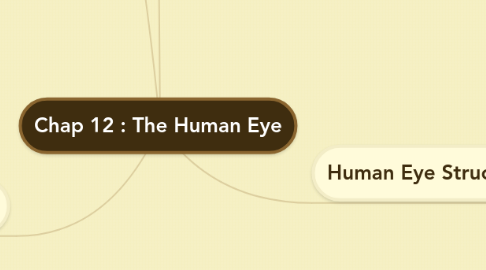
1. What Are Sense Organs?
1.1. Receive stimuli from the environment
1.2. Inform body of any changes in the environment
1.2.1. Task
1.2.2. Prerequisites
2. How do we See ?
2.1. When light falls on an object , rays of light are reflected from the object. Some of these reflected rays fall on the eye
2.1.1. Nerve Impulses are formed
2.2. 1 ) The light rays are refracted through the cornea and the aqueous humour onto the lens
2.3. 2 ) The lens cause further refraction and rays converge to a focus on the retina
2.4. 3 ) The image on the retina stimulates either the rods or cones ( Depending on the intensity of light )
2.4.1. Image formed on the retina is :
2.4.1.1. Upside down ( inverted )
2.4.1.2. Laterally Inverted
2.4.1.3. Smaller in size than the actual object ( diminished )
2.5. Aqueous humour
2.5.1. Keeps the front of the eyeball firm and helps to refract light into the pupil
2.6. Right way up , front to back and the right size
3. Focusing
3.1. Definition : Focusing is the adjustment of the lens of the eye so that clear images of objects at different distances are formed on the retina
3.2. Thickness of the lens is adjusted, allowing light rays to be focused on the retina
3.3. Focusing on a distant object ( > 6 metres ) :
3.3.1. Light rays reflecting off the object are almost parallel to each other when reached the eye. Lines are then refracted through the cornea and aqueous humour into the pupil
3.3.2. 1 ) Ciliary muscles relax , pulling on the suspensory ligaments
3.3.3. 2 ) Suspensory ligaments become taut , pulling on the edges of the lens
3.3.4. 3 ) Lens become thinner and less convex , increasing its focal length
3.3.5. 4 ) Light rays from the distant object are sharply focused on the retina
3.3.6. 5 ) Photoreceptors are stimulated
3.3.7. 6 ) Nerve impulses produced transmitted by the optic nerve to the brain. The brain interprets the nerve impulses and the person sees the distant object.
3.4. Focusing on a near object :
3.4.1. Diverging light rays reflecting off the near object are then refracted through the cornea and aqueous humour into the pupil
3.4.2. 1 ) Ciliary muscles contract , relaxing their pull on the suspensory ligaments.
3.4.3. 2 ) Suspensory ligaments slacken , relaxing their pull on the lens
3.4.4. 3 ) The lens , being elastic , becomes thicker and more convex , decreasing its focal length
3.4.5. 4 ) Light rays from the near object are sharply focused on the retina
3.4.6. 5 ) Photoreceptors are stimulated
3.4.7. 6 ) Nerve impulses produced transmitted by the optic nerve to the brain. The brain interprets the nerve impulses and the person sees the near object.
3.5. Focal Length : The Distance between the middle of the lens and point of focus on the retina
4. Human Eye Structures
4.1. Hollow of the skull = Orbit
4.2. Each eyeball attached to the skill by rectus muscles ,which controls the eye movement
4.3. Cornea
4.3.1. Dome shaped transparent layer continuous with the sclera
4.3.2. Refracts of bend light rays into the eye
4.3.3. Cause most of the reflection of light that occurs in the eye
4.4. Conjunctiva
4.4.1. Thin transparent membrane covering the sclera
4.4.2. Mucous membrane
4.4.3. Secretes mucus, thus helping to keep the front of the eyeball moist
4.5. Iris
4.5.1. Circular sheet of muscles
4.5.2. Contains pigment, which gives eye its colour
4.5.3. Amount of light controlled by 2 sets of muscles in Iris, thus only the right amount of light should enter the eye
4.5.3.1. Circular Muscles
4.5.3.1.1. Arranged in a circle around the pupil
4.5.3.2. Radial Muscles
4.5.3.2.1. Arranged radially (Lines towards the pupil)
4.5.4. In Bright Light
4.5.4.1. 1 ) The Circular Muscles of the iris Contracts
4.5.4.2. 2 ) The Radial Muscles of the iris Relaxes
4.5.4.3. 3 ) The pupil becomes smaller or Constricts
4.5.4.3.1. Reducing the amount of light entering the eye
4.5.5. In Dim Light
4.5.5.1. 1 ) The Radial Muscles of the iris Contracts
4.5.5.2. 2 ) The Circular Muscles of the iris Relaxes
4.5.5.3. 3 ) The pupil enlarges or dilates
4.5.5.3.1. This increases the amount of light entering the eye
4.6. Pupil
4.6.1. Hole in the centre of iris
4.6.2. Allows light to enter the eye
4.6.3. Size of the pupil determines how much light enter the eye
4.6.3.1. Which is controlled by 2 sets of involuntary muscles in the iris
4.6.3.1.1. Antagonistic Muscles : Because when one set contracts ,the other set relaxes and vice versa
4.6.4. Pupil Reflex
4.6.4.1. Pupil Larger when Light intensity is Low
4.6.4.2. Pupil Smaller when Light intensity is High
4.6.4.3. At times , the light maybe so bright that the decreasing size is insufficient
4.6.4.3.1. Resulting, the eyelids to come close together to screen off part of the light
4.6.4.4. Stimulus ( Change in light intensity )
4.6.4.4.1. Receptor (Retina)
4.7. Eyelids
4.7.1. Protect the Cornea from mechanical damage
4.7.2. Squinting
4.7.2.1. When eyelids are partly closed
4.7.2.2. Prevents excessive light from entering the eye, which damages the light-sensitive tissues inside
4.7.3. Blinking
4.7.3.1. Spreads tears over the Cornea and Conjunctiva , which wipes dust particles off the cornea
4.8. Eyelashes
4.8.1. Shield the eye from dust particles
4.9. Tear Glands
4.9.1. Location : corner of upper eyelid
4.9.2. Secretes Tears
4.9.2.1. Washes away dust particles
4.9.2.2. Keep Cornea moist for atmospheric oxygen to dissolve, which then diffuses into the cornea
4.9.2.3. Lubricate the Conjunctiva
4.9.2.3.1. Reduce friction when the eyelids move
4.10. Sclera
4.10.1. Tough , white outer covering the eye
4.10.2. Protects the eyeball from mechanical damage
4.11. Retina
4.11.1. Innermost layer of eyeball
4.11.2. Light-sensitive layer on which images are formed
4.11.2.1. Contain Light-Sensitive cells or Photoreceptors
4.11.2.1.1. Cones
4.11.2.1.2. Rods
4.11.2.1.3. Connected to nerve-endings from optic nerve
